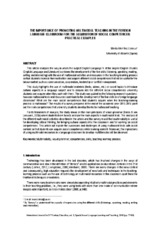Mostrar el registro sencillo del ítem
The importance of promoting multimodal teaching in the foreign language classroom for the acquisition of social competences: practical examples
| dc.contributor.author | Martínez Lirola, María | |
| dc.date.accessioned | 2018-11-22T10:52:56Z | |
| dc.date.available | 2018-11-22T10:52:56Z | |
| dc.date.issued | 2016 | |
| dc.identifier.issn | 2444-3921 | |
| dc.identifier.uri | http://hdl.handle.net/10396/17515 | |
| dc.description.abstract | This article analyses the way in which the subject English Language V of the degree English Studies (English Language and Literature) combines the development of the five skills (listening, speaking, reading, writing and interacting) with the use of multimodal activities and resources in the teaching-learning process so that students increase their motivation and acquire different social competences that will be useful for the labour market such as communication, cooperation, leadership or conflict management. This study highlights the use of multimodal materials (texts, videos, etc.) on social topics to introduce cultural aspects in a language subject and to deepen into the different social competences university students can acquire when they work with them. The study was guided by the following research questions: how can multimodal texts and resources contribute to the development of the five skills in a foreign language classroom? What are the main social competences that students acquire when the teaching-learning process is multimodal? The results of a survey prepared at the end of the academic year 2015-2016 point out the main competences that university students develop thanks to multimodal teaching. For its framework of analysis, the study draws on the main principles of visual grammar (Kress & van Leeuwen, 2006) where students learn how to analyse the main aspects in multimodal texts. The analysis of the different multimodal activities described in the article and the survey reveal that multimodality is useful for developing critical thinking, for bringing cultural aspects into the classroom and for working on social competences. This article will explain the successes and challenges of using multimodal texts with social content so that students can acquire social competences while learning content. Moreover, the implications of using multimodal resources in a language classroom to develop multiliteracies will be observed. | es_ES |
| dc.format.mimetype | application/pdf | es_ES |
| dc.language.iso | eng | es_ES |
| dc.publisher | Universidad de Córdoba, UCOPress | es_ES |
| dc.rights | https://creativecommons.org/licenses/by-nc-nd/4.0/ | es_ES |
| dc.source | International Journal for 21st Century Education 3(Special), 77-88 (2016) | es_ES |
| dc.subject | Multimodality | es_ES |
| dc.subject | Visual grammar | es_ES |
| dc.subject | Competences | es_ES |
| dc.subject | Skills | es_ES |
| dc.subject | Teaching-learning process | es_ES |
| dc.title | The importance of promoting multimodal teaching in the foreign language classroom for the acquisition of social competences: practical examples | es_ES |
| dc.type | info:eu-repo/semantics/article | es_ES |
| dc.relation.publisherversion | http://www.uco.es/ucopress/ojs/index.php/ij21ce/index | es_ES |
| dc.rights.accessRights | info:eu-repo/semantics/openAccess | es_ES |

